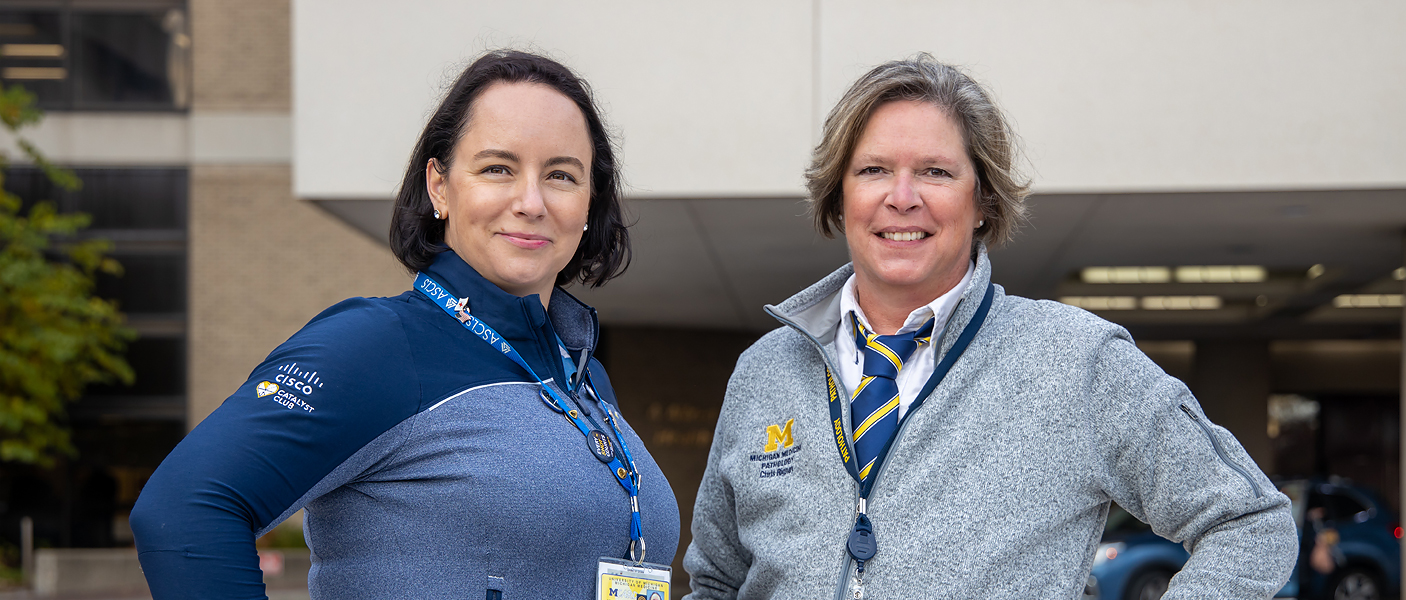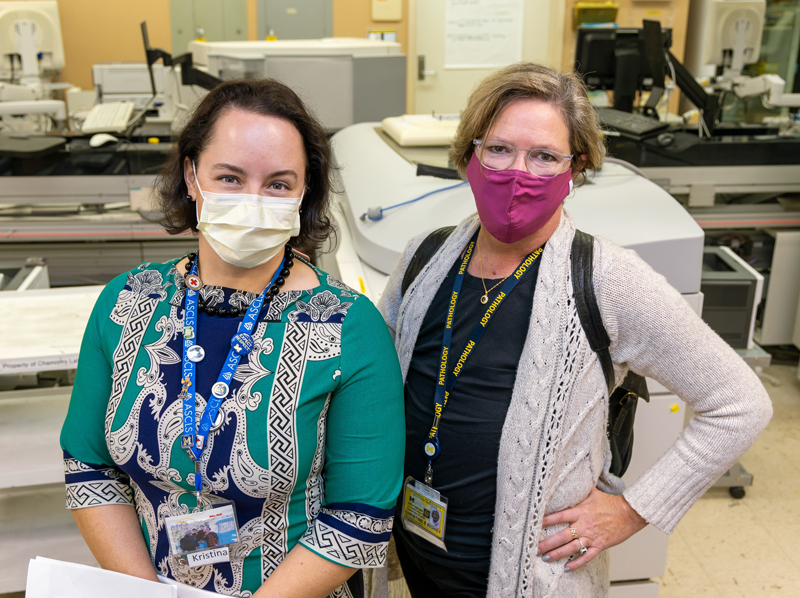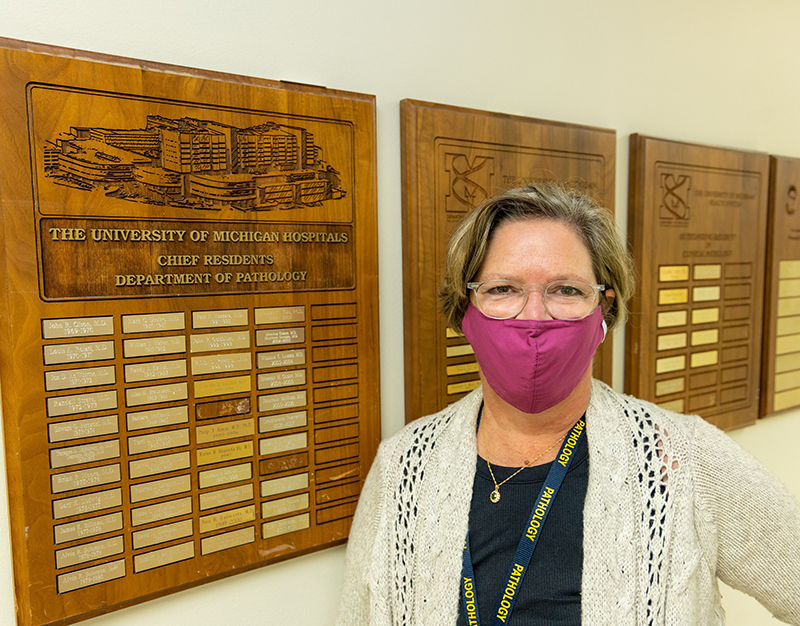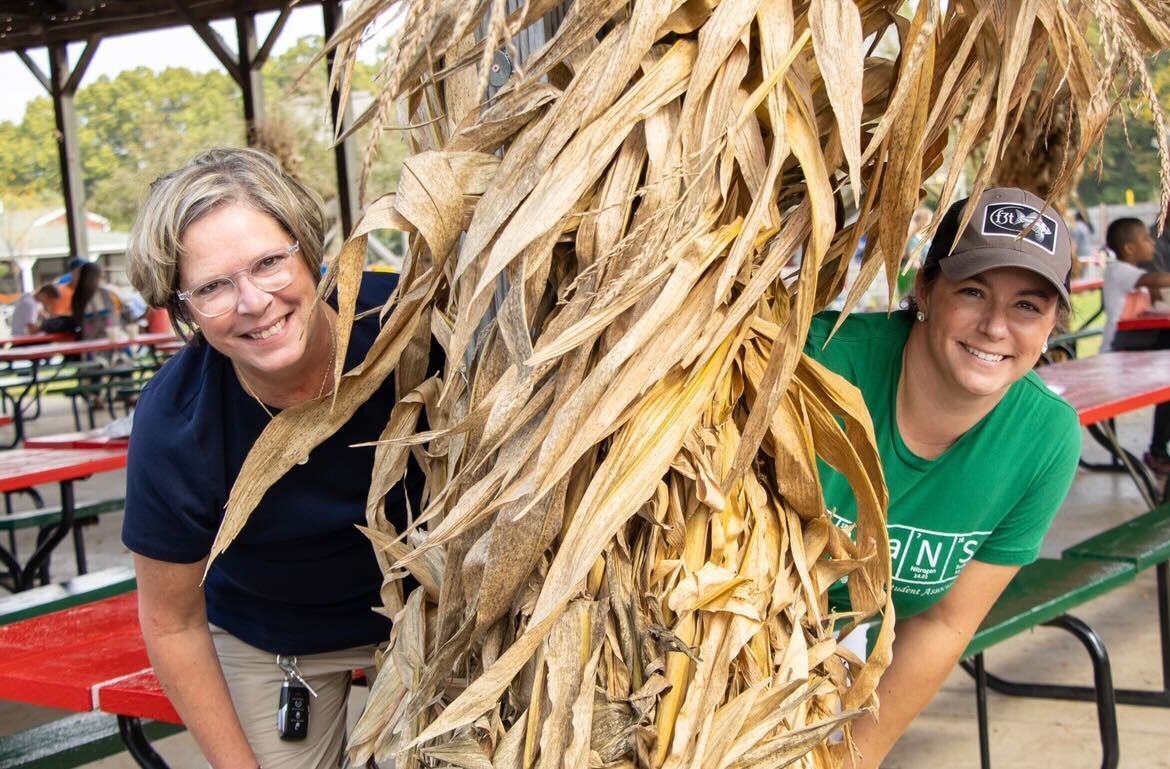

When patient specimens are collected, they are transported to the Department of Pathology’s Specimen Processing unit. From there, they are distributed to one or more of 15 laboratories housed within Pathology. Each of these laboratories have specialized equipment and trained laboratory staff to run more than 6 million tests annually. Overseeing the operations of these laboratories are Kristina Martin, Clinical Pathology Laboratory Operations Director, and Christine Rigney, Director of Laboratory Operations for the Division of Anatomic Pathology.
 Martin joined the Department of Pathology 14 years ago as a Specimen Processing supervisor. She later transitioned to the Clinical Pathology Operations Coordinator role and finally was promoted to the CP Operations Director position. Rigney has been with the Department for 21 years. She came to the Department as a histotech, working on the bench, and working as the frozen section tech in surgical pathology. About a year later, she was promoted to lead technologist in Histology and Surgical Pathology. When the Surgical Pathology supervisor position opened, Rigney was promoted. She later moved to an intermediate laboratory administrator role before being promoted again to the newly established director of laboratory operations position in Anatomic Pathology.
Martin joined the Department of Pathology 14 years ago as a Specimen Processing supervisor. She later transitioned to the Clinical Pathology Operations Coordinator role and finally was promoted to the CP Operations Director position. Rigney has been with the Department for 21 years. She came to the Department as a histotech, working on the bench, and working as the frozen section tech in surgical pathology. About a year later, she was promoted to lead technologist in Histology and Surgical Pathology. When the Surgical Pathology supervisor position opened, Rigney was promoted. She later moved to an intermediate laboratory administrator role before being promoted again to the newly established director of laboratory operations position in Anatomic Pathology.
The day-to-day responsibilities of a laboratory operations director in a complex, academic medical center cover a myriad of duties, each of which could be considered professional specialties in and of themselves. “We do operational planning, both internal to pathology as well as external to pathology across Michigan Medicine and the Michigan Medicine Laboratories clients,” stated Martin. “We are heavily involved in laboratory finance, procurement, leasing and service agreements, staffing justifications and HR-related issues, quality, safety, and compliance.” Rigney chimed in, “We are also the primary points of contact for emergencies, such as the recent fire at Michigan Medicine. We were on command center calls every hour or two until midnight the first day, then a couple of times a day since.” Rigney and Martin are also intricately involved in the planning and design whenever a new facility is being built, renovated, or opened, and when laboratory software systems are being considered or built. If it touches the laboratories in any way, Martin and/or Rigney are involved!
This is an exciting job that is never routine. There is always something to do. Martin finds her position to be particularly rewarding whenever she is involved with a process that leads to improved patient care or outcomes. She is also a mentor at heart and takes great pride in seeing staff members learning new roles or growing as leaders. Rigney agrees with these sentiments and adds, “I also get excited if, by some weird happenstance, patients or families are trying to find their way through the health system, and I am able to help them directly. It feels great to help and it reframes my own problems for that day. They are the real reason we are here, and it is what makes us great.”
 With the position’s complexity comes challenges with prioritizing many competing tasks. “Everything is very important, and we are constantly reprioritizing based on emergencies – like the pandemic or an HR issue that needs to be resolved in real-time,” stated Rigney. This is complicated by the innate bureaucratic inertia found in large, complex organizations. “The length of time it takes to get things done can be a challenge and frustrating at times,” reflected Martin. “Very often it seems there is no fast lane on our expressway. It takes patience & perseverance to thrive.” Despite this, when there is an emergency, like the pandemic, people rise to meet the challenge. “We have a very strong team in Pathology, and the pandemic demonstrated how leadership at every level in the health care system could pull together. We were navigating something we never lived through before,” related Rigney. “We pulled together, relied on each other, and always showed up.”
With the position’s complexity comes challenges with prioritizing many competing tasks. “Everything is very important, and we are constantly reprioritizing based on emergencies – like the pandemic or an HR issue that needs to be resolved in real-time,” stated Rigney. This is complicated by the innate bureaucratic inertia found in large, complex organizations. “The length of time it takes to get things done can be a challenge and frustrating at times,” reflected Martin. “Very often it seems there is no fast lane on our expressway. It takes patience & perseverance to thrive.” Despite this, when there is an emergency, like the pandemic, people rise to meet the challenge. “We have a very strong team in Pathology, and the pandemic demonstrated how leadership at every level in the health care system could pull together. We were navigating something we never lived through before,” related Rigney. “We pulled together, relied on each other, and always showed up.”
This teamwork was more important than ever during the pandemic. They faced shortages in staff, supplies, and other resources. “I never had to worry about having enough pipette tips in the laboratory until the pandemic. Never. I never had to be concerned about basic supplies like gloves being available. With the pandemic, everything was in short supply, and we had to figure out how to get the supplies and reagents we needed to do the testing,” stated Martin. “This required working a lot of hours, extremely long days, back-to-back for a very long time,” said Rigney. But on the other side, “I felt really good, impressed with our team, and I felt more a part of the team.”
Being a Laboratory Operations Director is a fulfilling, yet demanding career. “It requires you have a thick skin and that you are a servant leader,” explains Martin. “If you are in it for the money or the title, this is not the career for you,” added Rigney. Leaders at this level are on call 24/7. As such, the ability to be flexible is key and at times, duty will interrupt family and personal time. “You need to be a leader who walks with the team, someone people respect and want to follow,” she continued. “It is about passion, vision, developing great leadership skills, and maintaining them.” “You need to be resilient and intrinsically motivated,” Martin continued. “People can learn the finance, how to purchase equipment and other pieces, but more importantly, you need to be collaborative, open to figuring out how you can help in any situation, and not be worried about receiving recognition for everything you do. You need to be willing to volunteer and do all the little extras that prepare you for anything that may come your way.”
 With that being said, Martin and Rigney also enjoy having fun. Rigney is an avid golfer and has attended the Solheim Cup (women’s golf championship tournament) twice. She hopes to someday attend the Master’s Tournament and has applied for a ticket every year for the past 10 years. An interesting tidbit she shared is that prior to coming to Michigan Medicine, she worked as an artist for Metal Décor. She designed the donor wall art of Michigan Medicine’s front door view of the UH patient entrance. Her work currently hangs in the hallway at University Hospital. Martin also enjoys sports, but her favorite is softball. Serendipitously, in high school, her father’s coworker, Nova, attended her softball games, but they later lost touch. Nova was very supportive of Bold for the Cure, and Rigney, as a cancer survivor, became friends with her. “It was the same woman! How random is that?” exclaimed Martin.
With that being said, Martin and Rigney also enjoy having fun. Rigney is an avid golfer and has attended the Solheim Cup (women’s golf championship tournament) twice. She hopes to someday attend the Master’s Tournament and has applied for a ticket every year for the past 10 years. An interesting tidbit she shared is that prior to coming to Michigan Medicine, she worked as an artist for Metal Décor. She designed the donor wall art of Michigan Medicine’s front door view of the UH patient entrance. Her work currently hangs in the hallway at University Hospital. Martin also enjoys sports, but her favorite is softball. Serendipitously, in high school, her father’s coworker, Nova, attended her softball games, but they later lost touch. Nova was very supportive of Bold for the Cure, and Rigney, as a cancer survivor, became friends with her. “It was the same woman! How random is that?” exclaimed Martin.
 ON THE COVER
ON THE COVER
Breast team reviewing a patient's slide. (From left to right) Ghassan Allo, Fellow; Laura Walters, Clinical Lecturer; Celina Kleer, Professor. See Article 2014Department Chair |

newsletter
INSIDE PATHOLOGYAbout Our NewsletterInside Pathology is an newsletter published by the Chairman's Office to bring news and updates from inside the department's research and to become familiar with those leading it. It is our hope that those who read it will enjoy hearing about those new and familiar, and perhaps help in furthering our research. CONTENTS
|
 ON THE COVER
ON THE COVER
Autopsy Technician draws blood while working in the Wayne County morgue. See Article 2016Department Chair |

newsletter
INSIDE PATHOLOGYAbout Our NewsletterInside Pathology is an newsletter published by the Chairman's Office to bring news and updates from inside the department's research and to become familiar with those leading it. It is our hope that those who read it will enjoy hearing about those new and familiar, and perhaps help in furthering our research. CONTENTS
|
 ON THE COVER
ON THE COVER
Dr. Sriram Venneti, MD, PhD and Postdoctoral Fellow, Chan Chung, PhD investigate pediatric brain cancer. See Article 2017Department Chair |

newsletter
INSIDE PATHOLOGYAbout Our NewsletterInside Pathology is an newsletter published by the Chairman's Office to bring news and updates from inside the department's research and to become familiar with those leading it. It is our hope that those who read it will enjoy hearing about those new and familiar, and perhaps help in furthering our research. CONTENTS
|
 ON THE COVER
ON THE COVER
Director of the Neuropathology Fellowship, Dr. Sandra Camelo-Piragua serves on the Patient and Family Advisory Council. 2018Department Chair |

newsletter
INSIDE PATHOLOGYAbout Our NewsletterInside Pathology is an newsletter published by the Chairman's Office to bring news and updates from inside the department's research and to become familiar with those leading it. It is our hope that those who read it will enjoy hearing about those new and familiar, and perhaps help in furthering our research. CONTENTS
|
 ON THE COVER
ON THE COVER
Residents Ashley Bradt (left) and William Perry work at a multi-headed scope in our new facility. 2019Department Chair |

newsletter
INSIDE PATHOLOGYAbout Our NewsletterInside Pathology is an newsletter published by the Chairman's Office to bring news and updates from inside the department's research and to become familiar with those leading it. It is our hope that those who read it will enjoy hearing about those new and familiar, and perhaps help in furthering our research. CONTENTS
|
 ON THE COVER
ON THE COVER
Dr. Kristine Konopka (right) instructing residents while using a multi-headed microscope. 2020Department Chair |

newsletter
INSIDE PATHOLOGYAbout Our NewsletterInside Pathology is an newsletter published by the Chairman's Office to bring news and updates from inside the department's research and to become familiar with those leading it. It is our hope that those who read it will enjoy hearing about those new and familiar, and perhaps help in furthering our research. CONTENTS
|
 ON THE COVER
ON THE COVER
Patient specimens poised for COVID-19 PCR testing. 2021Department Chair |

newsletter
INSIDE PATHOLOGYAbout Our NewsletterInside Pathology is an newsletter published by the Chairman's Office to bring news and updates from inside the department's research and to become familiar with those leading it. It is our hope that those who read it will enjoy hearing about those new and familiar, and perhaps help in furthering our research. CONTENTS
|
 ON THE COVER
ON THE COVER
Dr. Pantanowitz demonstrates using machine learning in analyzing slides. 2022Department Chair |

newsletter
INSIDE PATHOLOGYAbout Our NewsletterInside Pathology is an newsletter published by the Chairman's Office to bring news and updates from inside the department's research and to become familiar with those leading it. It is our hope that those who read it will enjoy hearing about those new and familiar, and perhaps help in furthering our research. CONTENTS
|
 ON THE COVER
ON THE COVER
(Left to Right) Drs. Angela Wu, Laura Lamps, and Maria Westerhoff. 2023Department Chair |

newsletter
INSIDE PATHOLOGYAbout Our NewsletterInside Pathology is an newsletter published by the Chairman's Office to bring news and updates from inside the department's research and to become familiar with those leading it. It is our hope that those who read it will enjoy hearing about those new and familiar, and perhaps help in furthering our research. CONTENTS
|
 ON THE COVER
ON THE COVER
Illustration representing the various machines and processing used within our labs. 2024Department Chair |

newsletter
INSIDE PATHOLOGYAbout Our NewsletterInside Pathology is an newsletter published by the Chairman's Office to bring news and updates from inside the department's research and to become familiar with those leading it. It is our hope that those who read it will enjoy hearing about those new and familiar, and perhaps help in furthering our research. CONTENTS
|

MLabs, established in 1985, functions as a portal to provide pathologists, hospitals. and other reference laboratories access to the faculty, staff and laboratories of the University of Michigan Health System’s Department of Pathology. MLabs is a recognized leader for advanced molecular diagnostic testing, helpful consultants and exceptional customer service.